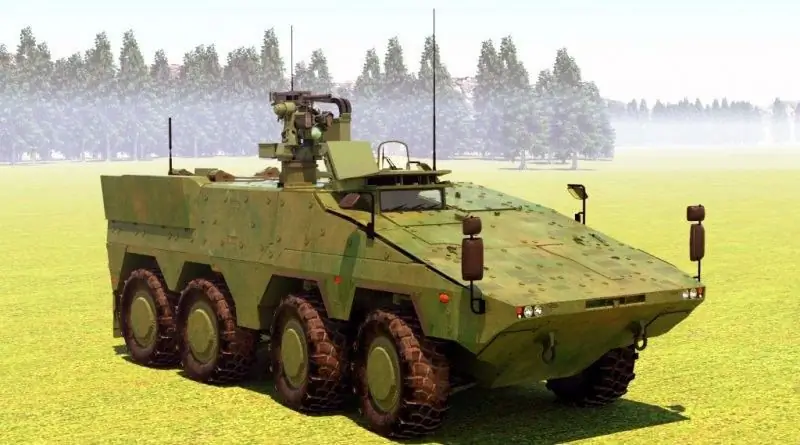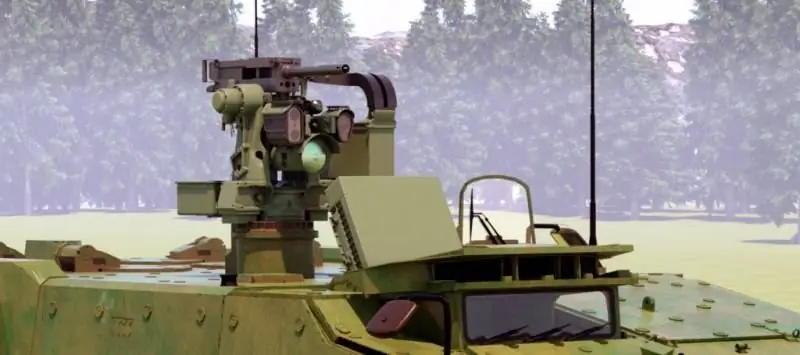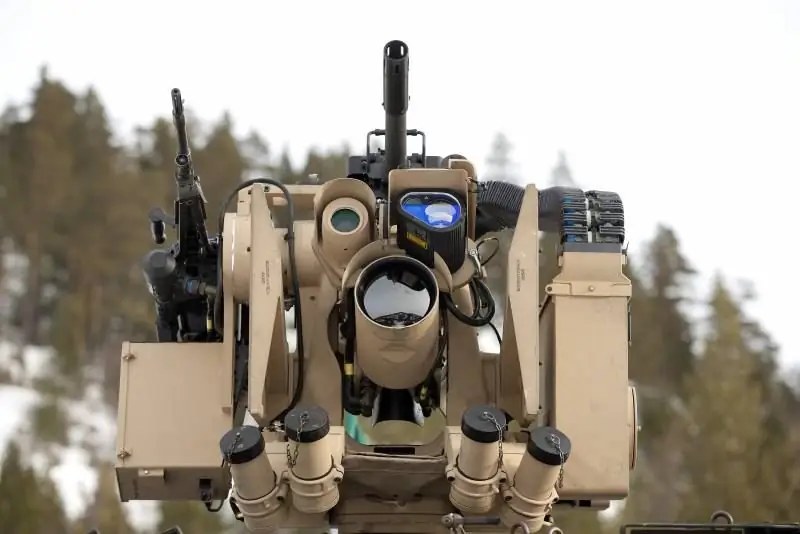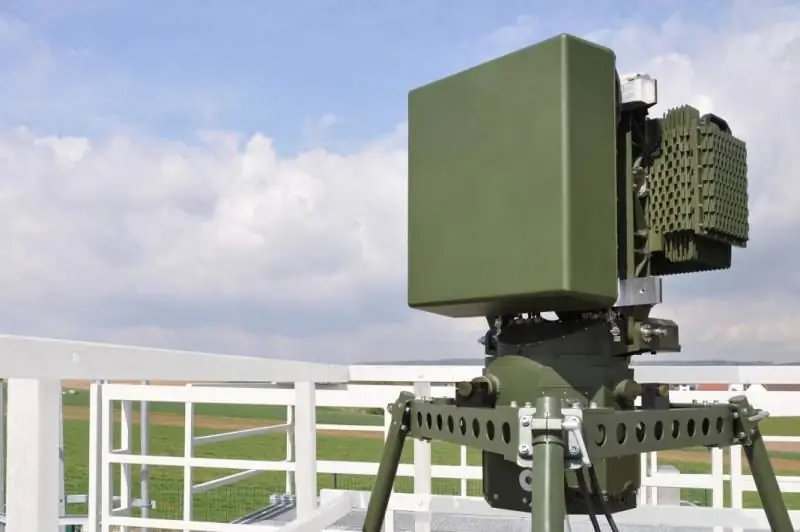- Author Matthew Elmers [email protected].
- Public 2023-12-16 21:49.
- Last modified 2025-01-24 09:17.

In the modern world, unmanned aerial vehicles have become absolutely commonplace. At the same time, all recent military conflicts demonstrate that the importance of UAVs is gradually increasing. Even ordinary civilian quadcopters, which are widely available and are notable for their low cost, are actively used and are quite an effective means of reconnaissance. Separately, it is possible to single out and loitering ammunition, which are actively developing in many countries of the world, including Russia. In these conditions, the emergence of specialized means of dealing with small drones was a matter of time. In Germany, for these purposes, they developed a full-fledged self-propelled anti-aircraft installation based on the Boxer armored personnel carrier.
ZSU to combat drones
Today we know that the Bundeswehr, at the end of 2019, signed a contract for the development and delivery of ten new self-propelled anti-aircraft guns to the troops to combat small unmanned aerial vehicles. The contract issued in December provides for the creation of new ZSU under the Qualifizierte Fliegerabwehr program. The new anti-aircraft self-propelled gun of the Bundeswehr will be based on the well-proven Boxer armored personnel carrier with an 8x8 wheel arrangement. It is assumed that the tests of the new ZSU should take place before the end of 2020, and the delivery of installations to the troops is planned to be completed by the end of 2021.
In the future, until 2023, all installations will become part of the German military contingent as part of the NATO High Readiness Joint Task Force (VJTF). The NATO High-Readiness Joint Task Force is an integral part of the Alliance Response Force and is a highly mobile force that can be deployed on site in a matter of days. It is assumed that the group will consist of five multinational brigades (numbering approximately 5 thousand people) with the support of air and naval forces, as well as special operations forces. At the same time, the German contingent will play a very important role in this group, which is partly explained by the desire to strengthen it with new air defense systems. In 2023, it will be Germany that will lead the Joint High-Readiness Task Force.
As part of the Qualifizierte Fliegerabwehr program in Germany, they created the simplest version of an anti-aircraft self-propelled installation, taking as a basis ready-made and well-proven components. So, a German-Dutch four-axle armored personnel carrier with an 8x8 wheel arrangement was chosen as the chassis for the ZSU. The vehicle turned out to be quite successful and is actively used in the armed forces of Germany and the Netherlands; Lithuania also acquired this armored vehicle in 2016. Australia and Great Britain also decided to re-equip with this combat vehicle. The 33-ton combat vehicle is distinguished by a very good level of protection, high mobility and mobility due to the installation of a 720 hp engine.

The Boxer armored combat vehicle can carry various weapons systems, including heavy ones. Variants of use as a wheeled tank or a wheeled self-propelled artillery unit are possible. In this regard, it is not unusual that the Bundeswehr decided to use this particular chassis to accommodate means of destruction of small unmanned aerial vehicles. On the other hand, this is not the cheapest option, considering that the cost of one Boxer armored personnel carrier is about 4 million euros and can be changed based on the chosen modification.
For installation on the chassis of the Boxer armored personnel carrier, the well-proven remote-controlled combat module Protector manufactured by the Norwegian company Kongsberg was chosen. The module is complemented by a new radar for detection and target designation of the well-known German company Hensoldt, whose main activity is precisely the creation of radars, as well as optoelectronic systems and avionics. On the new ZSU, the Germans placed the most modern of the Spexer radars, the Spexer 2000 3D Mk III (the third generation of these radars).
Combat module Protector plus radar Spexer
The heart of the new German self-propelled anti-aircraft gun will be the Protector combat module, which is paired with a stationary small-sized AFAR Spexer radar. Both products deserve special attention. It is known that Kongsberg will receive 24 million euros for the supply of 10 sets of Protector remotely controlled combat modules (as part of the Qualifizierte Fliegerabwehr ZSU program).
The Protector remotely controlled combat module, for the production of which Kongsberg Defense & Aerospace and the French Thales Group are responsible, is quite widespread today not only in Europe, but also overseas, as it is used in the US armed forces. The combat module makes it easy to deploy various weapons systems on it: machine guns of different calibers, automatic grenade launchers, ATGMs, automatic cannons of 20-50 mm caliber, etc. In this case, the module itself consists of a platform that is installed on a vehicle, a fire control system and controls. Additionally, the module can be equipped with smoke grenades. The mass of the module without ammunition and weapons is estimated at 135 kg, the installation height is 749 mm.

As part of the ZSU Qualifizierte Fliegerabwehr project in the Bundeswehr, they decided to equip their installation with a 40-mm automatic grenade launcher manufactured by the German company Heckler & Koch. This solution is quite common for the Protector combat module. In this case, the main ammunition for the automatic grenade launcher will be shots with controlled remote detonation. The use of such ammunition is a guarantee of effective destruction of UAVs. At the same time, the installation is initially sharpened to combat small unmanned aerial vehicles (sUAS), including civilian models, which are widely represented on the market today and are available to almost everyone.
The HK GMG grenade launcher itself was developed back in the mid-1990s and is considered a fairly successful example of a weapon in its class. Like all NATO grenade launchers, the model is designed to use 40x53 mm ammunition. The rate of fire of the HK GMG automatic grenade launcher reaches 350 rounds per minute, the aiming range is up to 1500 meters, and the maximum range is 2200 meters. This is more than enough to combat all ultra-small drones.
For effective detection and tracking of small air targets, the Germans decided to use a small-sized fixed AFAR radar Spexer 2000 3D Mk III. This is a stationary radar with an active phased antenna array of the X-band (operates in the frequency band 9, 2-10 GHz), specially designed for detecting small-sized air targets. The azimuth view of the fixed version is 120 degrees. At the same time, as noted by the manufacturer of the radar, if necessary, the system can be easily upgraded to provide full 360-degree coverage.

The radar is quite compact in size, its weight does not exceed 40 kg, while the dimensions of the antenna are also modest: 600x400x300 mm. The maximum detection range of air targets is 40 kilometers, while the capabilities of the radar make it possible to detect even ultra-small drones at a distance of up to 2.5 km, after which their defeat becomes only a matter of technology. The radar antenna emits from 1 to 16 beam signals with a variable frequency, which allows the operator to detect even small and fast-moving targets, including UAVs. A distinctive feature of the Spexer 2000 3D Mk III radar is the ability to simultaneously track more than 300 different targets. The Germans call another advantage of the Hensoldt radar an intuitive and simple "man-machine" interface, which resembles working with any modern gadgets. The operator sees on the screen all types of targets that have been detected and classified using the radar.
Hensoldt has high hopes for the Spexer range of radars. Their capabilities are not limited to the detection of ground, sea or air targets. Over time, it is on the basis of this device that the company's engineers are going to build a promising set of active protection for armored vehicles. According to the company's roadmap, in five years Hensoldt expects to create radars that will confidently detect small targets flying at a speed of 1,500 m / s. In the future, this will help to use the radar to combat armor-piercing projectiles, including modern sub-caliber ammunition, which pose a particular danger to armored military equipment.






